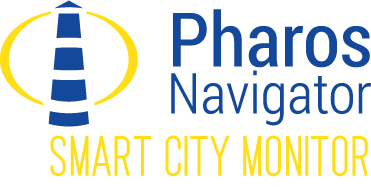Outstanding functionalities
What are the main outstanding features of the platform compared to existing online ones?
At first sight one may find some of the city applications presented at Smart City Monitor demo looking similar to others available in Internet providing business services, car sharing, parking places, hotels, etc and its viewing on maps. However it is not!
Tthe Smart City Monitor urban technology has unique outstanding capacities and important principal differences to many other solutions as follows:
- Presenting civic processes in real time: The Smart City server calculates the ongoing performance of any urban or business object and presents its processes in real time in various analytics. It can be linked to other smart everything in the districts, neighboring towns, enterprises, moving objects (busses, trains, ships, etc) and citizens.
- Relation to concrete unique urban model: The civic information services and controls are always related to the concrete structure and properties of real life urban area presented by its comprehensive urban model which is kept updated by the local Smart City Team. The model has all necessary urban objects, its relations to sub-objects, indicators, data sources, video cameras, etc enabling relevant digital transformation to reveal complex city processes and its interlinkages.
- Minimized efforts of keeping the model up to date: While running on the Smart City server, the data driven model is linked to large number of sensors, IoT, automatic control systems of utility providers like SCADA (water, waste, energy, streetlights, traffic) and public and private enterprise systems and various open data sources. The interactive instruments in the Smart City Monitor platform enable local Smart City Teams to keep the local urban model up to date, easy adding/modifying its structure, indicators and data sources, linking sensors, video cameras and smart systems.
- Customization and focusing the information service content: The ongoing urban processes, events, performance results and predictive maintenance notices may be presented in diverse customized interactive reports addressing the needs of any necessary stakeholder group such as administration, utility providers, local businesses, citizens and tourists. It may provide aggregated real time information about any target object or groups of objects such as buildings, busses in traffic, enterprises and citizens in that district, etc, which is calculated promptly upon the receipt of any new piece of data in the data streams. It includes holistic vision of the city and its infrastructure, current status of each object, its specific custom indicators and its combinations, e.g. energy consumption, temperature, number of visitors in the building, status of a bus on particular route with number of passengers in it, ongoing total costs of passenger transportation on the route, and many others.
- Enabling new business ecosystem: The new smart city technology creates easy customizable environment for experimenting with new business models. For example local administration can offer agreements with local businesses enabling them to present ongoing information about business services, its quality in real time to promote their business content while generating new revenue stream to the community budget. The event providers and businesses responsibility and transparency increases accordingly to their agreements with the city administrations while the community events obtain larger potential audience. The public information always reflects existing policies, priorities and focused on interests of local communities and is independent from commercial interests of third parties.
- Opening attractive mobile apps for citizens and tourists: The comprehensive urban model content enables diverse optional mobile applications (using APIs) by various business providers under the agreement with the community administration. The results can be made available and effectively support daily life of the citizens and tourists as well as propose their participation and involvements by presenting the available services and events on city map, dashboards and reports in real time. The citizens may contribute to own city life with various forms of crowd sourcing starting from prompt reporting on some city problems and connecting own sensors (noise, CO2, etc) to Smart City environmental maps and providing other content as materials, work, food, information to participation in evaluation of city budgets, new projects and quantitative feedbacks on services. The Smart City Monitor server immediately process each feedback and provides relevant update of performance rating for continuous improvements in quality and content of events by its providers.
- Accumulating the evidence of growths and achievements: The big urban data and performance results are stored in the Smart City Monitor server and are always available for various applications such as data mining, analysis, statistics, planning and simulation of decisions.
The described features are among many others which are based on the Smart City Monitor capacity to transform multiple data streams from urban objects and processes into customized information services and controls. The selection of functions for implementation in particular metropolitan and urban areas is made by the local administrations based on the Smart City projects requirements.
The brief overview of the undelying disruptive technology (download)
2025 © GOLEM IMS GMBH, Austria. ALL Rights Reserved.
Terms of Service |
Privacy Policy
Made in Austria

